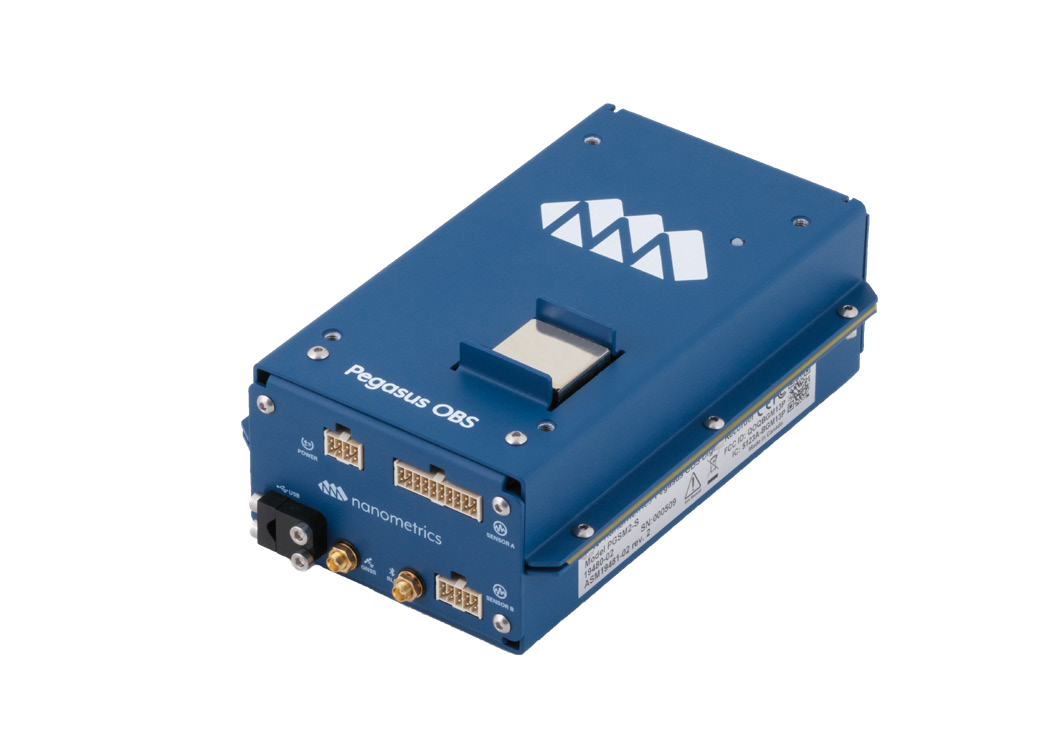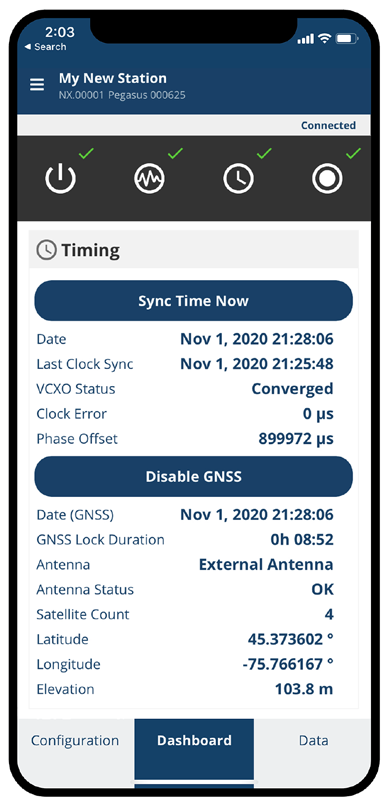PEGASUS OBS DIGITAL RECORDER DATA ACQUISITION SYSTEM
Last-Release:2024-04-03 15:44:52 Font Size:T|T
An intuitive and versatile ecosystem for ocean bottom experiments

Designed specifically for ocean bottom experiments, the Pegasus OBS workflow optimizes onshore and shipboard processes to address common challenges of this demanding environment. A compact and mobile integrated seismic acquisition system, Pegasus OBS combines high fidelity data acquisition with ultra-low power consumption to provide a versatile platform for any experiment.
From Experiment Design to Publishing
Streamlined Workflow
The Pegasus OBS workflow allows you to effectively plan your deployment and pre-configure the digitizer and sensor prior to boarding the ship. Once on-deck, the system configuration can be set or adjusted using the Bluetooth enabled mobile app,all without needing to open the pressure vessels.Ultra-low Size, Weight and Power
The remarkably small form factor and low power consumption of the Pegasus OBS digital recorder minimizes the cost of batteries, extends maximum experiment duration, reduces overall station size requirements, and simplifies integration into existing systems or new vessel designs.Versatile Sensor and Power Compatibility
Pegasus OBS supports a broad range of sensor types including active and passive seismometers or geophones, pressure gauges and hydrophones. Four input channels permit simultaneously recording seismic and pressure or hydroacoustic signals.The Pegasus OBS can utilize a wide range of power sources, allowing you to select the battery technology that best suits the experiment. A separate backup power input permits use of a reserve battery to keep the timing system running even after the main batteries are depleted, to ensure that the clock drift can always be compared against GNSS at the end of an experiment.
High-Precision Timing
Pegasus OBS’high-precision timing system includes a low-drift temperature compensated clock, a real-time clock, and an internal GNSS receiver. Simple one-tap mobile app actions synchronizes the internal clock to GNSS time just before deployment, and measures time drift offset relative to GNSS time immediately after recovery.Complete Ready-to-Process Data
Retrieving data has never been easier for OBS deployments. The Pegasus OBS digitizer automatically produces complete, ready-to-use data in MiniSEED format along with StationXML instrument response and experiment metadata. Retrieve 1 year of 4-channel 100 sps data in less than 2 minutes, all without having to open the pressure vessel. Optionally, a linear time corrected dataset based on total drift can automatically be created at the time of data retrieval.Purpose Built, OBS Workflow
Every aspect of the Pegasus OBS ecosystem has been optimized to provide the greatest efficiency for ocean bottom experiments.• Powerful pre-planning tools
• Bluetooth mobile interface allows you to configure the digitizer without opening the pressure vessels
• Low SWaP (Size, Weight and Power) minimizes battery cost and overall system size
• Retrieve 1 year of 4-channel 100 sps data in less than 2 minutes
• High fidelity data produced by very low noise, high precision digitizer technology
• Complete, ready to analyze datasets
iOS and Android apps connect seamlessly over Bluetooth to provide the primary on-deck interface for the Pegasus OBS.

TECHNICAL SPECIFICATIONS PEGASUS OBS DIGITAL RECORDER
DIGITIZER PERFORMANCE & CAPABILITIES
Sampling: Simultaneous on all channelsResolution: 28 bit for ≤ 10 sps
26 bit for 20 to 50 sps
24 bit for ≥ 100 sps
Accuracy: Nominal gain accurate within ±0.5%
Dynamic Range (typical): 142 dB @ 20 sps, 135 dB @ 100 sps (40 Vpp (1x gain), full-scale peak to RMS shorted-input noise)
Preamp Gain: 1x, 4x, 10x, 40x, 80x Sensor A and B independently selectable
Sample Rates: 1, 2, 5, 10, 20, 40, 50, 100, 200, 250, 500, 1000 sps Sensor A and B independently selectable
Decimation Anti-Aliasing Filter
• Selectable linear phase (noncausal) or minimum phase (causal)
• -140 dB (linear phase) at output Nyquist frequency, 0 dB at 80% Nyquist
• -140 dB (linear phase) at output Nyquist frequency, 0 dB at 80% Nyquist
SENSOR INPUTS
Channels: 3-channel Sensor A port and 1-channel Sensor B portInput Voltage Range (Peak-to-peak differential): 40 V, 10 V, 4 V, 1 V, 0.5 V
Also compatible with single-ended inputs: Up to 20 V peak-to-peak (±10 V)
Input Impedance: 1.7 MΩ (40 kΩ for 40 Vpp range)
SENSOR COMPATIBILITY
Sensor Types: Differential analog sensors such as broadband seismometers, geophones,accelerometers, hydrophones, pressure gauges
Control Lines: 3 on Sensor A and 1 on Sensor B port — typically used for mass center, and selecting XYZ/UVW or SP/LP modes
Sensor Power:
• Supply power pass-through to sensor channels (9-17 V DC, 1 A)
• Over-current protected
Auto Mass Centering:Configurable thresholds, intervals
Serial Interface: Sensor A supports digital management of Nanometrics sensors
DATA RECORDING & RETRIEVAL
Data sets:• Waveform data: miniSEED, STEIM2 compressed or export in SEG-Y
• Station metadata including instrument response: StationXML
• State-of-Health: miniSEED
• Instrument logs
Internal Memory: High reliability 128 GB eMMC• Station metadata including instrument response: StationXML
• State-of-Health: miniSEED
• Instrument logs
Data Download: USB3.0 Superspeed (>100MB/s) to application available for Windows, OSX, and Linux
User Interface: Bluetooth connectivity with mobile application (iOS and Android) for configuration and live view of waveforms and state-of-health
TIMING - GNSS & PRECISION NETWORK TIMING
Timing System: Internal VCXO clock disciplined to Seascan time base module, synchronized to GNSS UTC timing source pre/post deploymentFree-running Timing Source: Seascan SISMTB time base module (customer serviceable)
Free-running Timing Stability:
• Pre-correction: 4.3 msec/day
• Post-correction: 0.04 msec/day (typical)
GNSS Timing Receiver: Internal 33-channel GNSS module• Post-correction: 0.04 msec/day (typical)
GNSS Timing Source: Selectable from GPS, GLONASS, BeiDou, Galileo, QZSS
GNSS Timing Accuracy: Typical < 3 µs to UTC with GNSS lock
GNSS Power: Selectable: OFF or Temporarily ON (pre/post deployment)
Timing Clock Output: 1 Hz Pegasus system time top of second, 125 Hz passthrough from Seascan
POWER
Main Power Supply: 9-17 V DC non-isolated input (via Power connector) or 5 V DC USB for HarvestingTiming System Reserve Power: 4-17 V DC Automatically enabled when main power drops below reserve power voltage Reserve power voltage must be less than the configured low-voltage shutdown for main power
Power-up: <5 seconds
Protection: Electronic resettable fuse design, reverse battery protection
Battery Manager: User-configurable low voltage shutdown and restart thresholds
CERTIFICATIONS
Regulatory: CE 2014/53/EU (RED), FCC, IC, RoHSPOWER USAGE (TYPICAL)
Normal Mode: < 200 mW for 3 channels, < 240 mW when 4th channel is enabled
Timing System Reserve Mode: 6 mW for persistent timing system when on reserve battery
CONNECTORS & LEDS
Sensor A (3-channel): 20-pin Samtec connector for timing outputs and reserve power input
Sensor B (1-channel): 10-pin Samtec connector for timing outputs and reserve power input
Power/Telemetry: 8-pin Samtec connector for timing outputs and reserve power input
USB: USB-C receptacle
BLE Antenna: MCX (female) for dipole antenna
GNSS Antenna: MCX (female) with 3.3 V supply for active antenna
Rear Auxiliary Header: 16-pin Samtec connector for timing outputs and reserve power input Seascan Timing Mount: 26-pin Samtec connector for Seascan time base modules with .230” pins or .320” pins (when used with alternate standoffs supplied)
ENVIRONMENTAL
Operating Temperature:–5°C to +35°CStorage Temperature: –40°C to +70°C
Humidity: Up to 90% non-condensing
PHYSICAL CHARACTERISTICS
Housing: Aluminum alloyWeight: 500 g
Size: 168 mm (L) x 103 mm (W) x 67 mm (H)
AVAILABLE MODELS
PGSM2-S: Seascan clock includedPGSM2-N: Seascan clock not included

